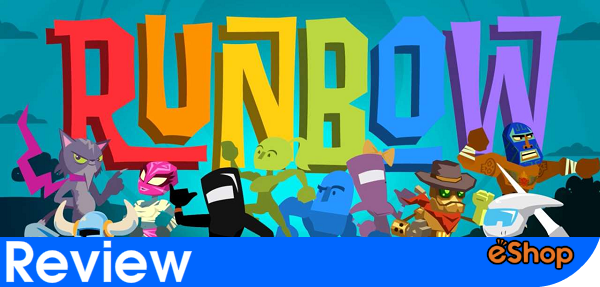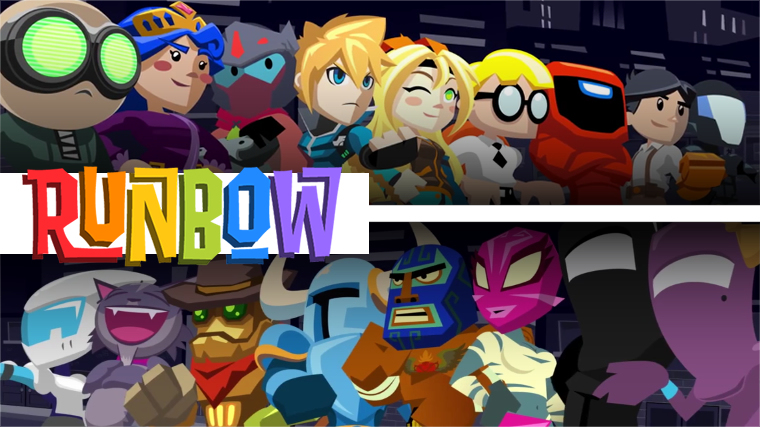

Cue Runbow.
Platforming games are almost synonymous with Nintendo, with Super Mario Bros. and Metroid leading the way in a multitude of titles. In the same vein so are party games, mentioned before the likes of Mario Kart and Super Smash Bros. are prime examples. So what if you were to combine them? Essentially, that’s exactly what Runbow is!
The game’s user interface is as granted, very simply running with your character into a world of platforms and obstacles, collecting power-ups and attacking (you can even chain into a directional dash attack – neat!)
However, there’s a twist.
As you run the background colour changes with time, splashing across the stage, so suddenly obstacles or platforms of the same shade that were once there… Gone. The laser beams that you saw? Oh they’re still there.. better hurry! Don’t understand what I mean? Let’s say the current background is blue. You see 2 green platforms and a green laser beam obstacle. Suddenly the background changes to green, and those platforms and that laser beam disappear. However, now appears some new blue platforms and a blue laser hidden away by the previous hue. Obviously, both reaction time and hand-eye coordination are being tested more than ever in this colourful game.
The single-player modes have enough content to last you a very long time, doubly so if you weigh content via a price tag. The campaign’s story line regards crossing a myriad of crazy puzzle like stages in trial-like fashion which you have to do perfectly each time to move on. You’re also ranked on how long it takes you to do it as well, so pay attention to that, especially because it helps with unlocking extra content. After clearing a certain pattern of puzzles in the selection menu, you can choose special levels to clear to face the villain of the game, Satura. Completion of these set you on to the new world to take on the seemingly never ending series of stages in store for the player.
In addition to the adventurous Story Mode, there is one called ‘Challenge the Bowhemoth’. Unlike its counterpart, this mode has no checkpoints and is very very punishing. Think ‘The Impossible Game’ and ‘Super Meat Boy’; extremely hard courses that end too easily, have low rewards and require perfection from the second you begin. Just how I like it.
Despite being called ‘single-player,’ these modes offer up to 9 players locally, so gather your friends for some Runbow and Smash. You can use many of the Wii U’s controller peripherals, and it’s done in such a way to accommodate as many people as possible. For example, you can have one person play using just the Wii remote as well as another on the nun-chuck connected to it. Not many games offer this, and personally I found it to be a really cute touch.
The rest of modes can be played by oneself, but the true depth is found via competition with others. Competitive platformers always sound a bit iffy; many, many titles have done it wrong. However, Runbow does it right.
These remaining modes find their true quality played with your friends, locally as stated but can be integrated into online multiplayer with people around the world. The main one is the free running mode, where all players start from the beginning and try their best to make it past the stage barriers (…and each other!) to reach the end and collect the trophy. On the way, there are many power-ups that are very important, as they can easily decide who would win the round or not, such as super speed, flipping the screen or even switching places with someone else. After 10 trials, whoever won the most overall wins the game. Despite how easy it sounds, you’d be humbled by the experience, I can assure you that.
The other modes are Arena and King of the Hill. As they both imply, it’s survival of the fittest, and much like Super Smash Bros., the last survivor who isn’t cast into oblivion wins. These modes are where you have to use the attacking options more intelligently than ever to assure your victory.
The last mode is local-multiplayer only, called Colour Master. It’s very similar to Boost Mode in New Super Mario Bros. U. The person using the Wii U’s gamepad doesn’t directly play the game, instead controls the games obstacles and platforms via the ability to change the colour of the background to confuse the other players. It’s not the most endearing mode, but it’s a nice addition in this party game.
Despite the simplicity of the modes and gameplay mentioned, don’t let that detract you from thinking it’s anything like that. The competitive form of the game has serious depth, thinking is critical and decisions must be made in less than a second, less than a frame has passed sometimes, just to get the upper hand.
A lot of things stood out for me while playing this game. When I first put it on, the first thing that reached out to me was the fantastic soundtrack. Good video game music is something rare nowadays, with many games throwing off generic forgetful music. However, I can still feel the rhythm of the jazzy tones I beat my head to from Runbow as I write this, just take a listen from this sample. There is an option in game to listen to the music you’ve uncovered whilst playing the game.
Additionally there are many avatars you can play as, the first being the generic female Val and her male counterpart Hue, obvious puns of the Physics governing colours – Hue and Value. You can dress them up and change their colours as you unlock things with progress in the game, but that’s the least special thing in terms of avatars. Like I mentioned before, Indie projects are a big, big thing for Nintendo this year, and I was pleasantly surprised to see that you can play as one of many more popular protagonists of notable Indie games, such as Shovel Knight, Gunvolt, Rusty from Steam Dig World, a Teslamancer from Teslagrad and many others. Most notable in the list was the addition of Unity-chan, the mascot of the Japanese Development studios “Unity Technologies”, whose game engine is used internationally and resulted in renowned titles such as Angry Birds, City: Skylines and Hearthstone : Heroes of Warcraft. The fact that a non-gaming character of a third-party company found its way to a game feels just at home with Nintendo, and I love it so much.
And finally, the one feature that really stood out to me, though vastly popular with many other games and platforms, was the presence of an achievement feature. Undeservedly absent in many, many Nintendo games and consoles, it’s found here and plays a part in unlocking most of the special features, such as music, artwork and the special playable avatars.

Special characters in Runbow, with more to come.
From the get go, the game oozes personality, with its fantastic game options, quality party potential, special characters, challenging difficulty and a soundtrack made to keep you bopping your head for more. You can dash, jump, uppercut or even taunt your way to victory, and above all, for a meagre $14.99 on the eShop with promises of free updates, I can assure you that Runbow is a great game that is on par with the legacy of Nintendo’s brand. This is apparently the first release from the folks down at 13AM games, and it must be said that they’ve indeed done a great job. For any fan of a platforming game who wants something to play with friends, this game was handpicked from your dreams and desires.
After being presented with a plethora of addictive, entertaining and immensely fun hours of gaming, I can’t help but give this game a high score. High replay value, challenging courses, rich background music and the chaotic multiplayer that we all love about Nintendo work in favour with the many factors promoting my liking for this game, with the only downfall being that there wasn’t a special feature making use of the touchscreen or gyroscopic sensors of the the Wii U’s gamepad. That being said, it’s a game that finally does the platforming party genre its overdue justice.